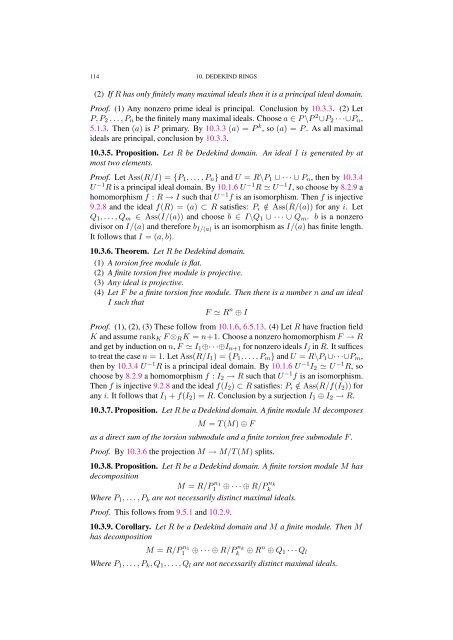Commutative algebra - Department of Mathematical Sciences - old ...
Commutative algebra - Department of Mathematical Sciences - old ...
Commutative algebra - Department of Mathematical Sciences - old ...
You also want an ePaper? Increase the reach of your titles
YUMPU automatically turns print PDFs into web optimized ePapers that Google loves.
114 10. DEDEKIND RINGS<br />
(2) If R has only finitely many maximal ideals then it is a principal ideal domain.<br />
Pro<strong>of</strong>. (1) Any nonzero prime ideal is principal. Conclusion by 10.3.3. (2) Let<br />
P, P2 . . . , Pn be the finitely many maximal ideals. Choose a ∈ P \P 2 ∪P2 · · ·∪Pn,<br />
5.1.3. Then (a) is P primary. By 10.3.3 (a) = P k , so (a) = P . As all maximal<br />
ideals are principal, conclusion by 10.3.3.<br />
10.3.5. Proposition. Let R be Dedekind domain. An ideal I is generated by at<br />
most two elements.<br />
Pro<strong>of</strong>. Let Ass(R/I) = {P1, . . . , Pn} and U = R\P1 ∪ · · · ∪ Pn, then by 10.3.4<br />
U −1 R is a principal ideal domain. By 10.1.6 U −1 R U −1 I, so choose by 8.2.9 a<br />
homomorphism f : R → I such that U −1 f is an isomorphism. Then f is injective<br />
9.2.8 and the ideal f(R) = (a) ⊂ R satisfies: Pi /∈ Ass(R/(a)) for any i. Let<br />
Q1, . . . , Qm ∈ Ass(I/(a)) and choose b ∈ I\Q1 ∪ · · · ∪ Qm. b is a nonzero<br />
divisor on I/(a) and therefore b I/(a) is an isomorphism as I/(a) has finite length.<br />
It follows that I = (a, b).<br />
10.3.6. Theorem. Let R be Dedekind domain.<br />
(1) A torsion free module is flat.<br />
(2) A finite torsion free module is projective.<br />
(3) Any ideal is projective.<br />
(4) Let F be a finite torsion free module. Then there is a number n and an ideal<br />
I such that<br />
F R n ⊕ I<br />
Pro<strong>of</strong>. (1), (2), (3) These follow from 10.1.6, 6.5.13. (4) Let R have fraction field<br />
K and assume rankK F ⊗RK = n+1. Choose a nonzero homomorphism F → R<br />
and get by induction on n, F I1⊕· · ·⊕In+1 for nonzero ideals Ij in R. It suffices<br />
to treat the case n = 1. Let Ass(R/I1) = {P1, . . . , Pm} and U = R\P1∪· · ·∪Pm,<br />
then by 10.3.4 U −1 R is a principal ideal domain. By 10.1.6 U −1 I2 U −1 R, so<br />
choose by 8.2.9 a homomorphism f : I2 → R such that U −1 f is an isomorphism.<br />
Then f is injective 9.2.8 and the ideal f(I2) ⊂ R satisfies: Pi /∈ Ass(R/f(I2)) for<br />
any i. It follows that I1 + f(I2) = R. Conclusion by a surjection I1 ⊕ I2 → R.<br />
10.3.7. Proposition. Let R be a Dedekind domain. A finite module M decomposes<br />
M = T (M) ⊕ F<br />
as a direct sum <strong>of</strong> the torsion submodule and a finite torsion free submodule F .<br />
Pro<strong>of</strong>. By 10.3.6 the projection M → M/T (M) splits.<br />
10.3.8. Proposition. Let R be a Dedekind domain. A finite torsion module M has<br />
decomposition<br />
M = R/P n1<br />
nk<br />
1 ⊕ · · · ⊕ R/Pk Where P1, . . . , Pk are not necessarily distinct maximal ideals.<br />
Pro<strong>of</strong>. This follows from 9.5.1 and 10.2.9.<br />
10.3.9. Corollary. Let R be a Dedekind domain and M a finite module. Then M<br />
has decomposition<br />
M = R/P n1<br />
1<br />
⊕ · · · ⊕ R/P nk<br />
k ⊕ Rn ⊕ Q1 · · · Ql<br />
Where P1, . . . , Pk, Q1, . . . , Ql are not necessarily distinct maximal ideals.
















